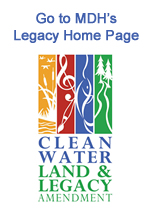Clean Water Fund: Contaminants of Emerging Concern (CEC)
MDH Legacy Initiatives
- Clean Water Fund Home
- Contaminants of
Emerging Concern - Groundwater Protection Initiative - Accelerated Implementation Grant
- Groundwater Restoration and Protection Strategies (GRAPS)
- Pathogen Project
- Private Well Protection
- Source Water Protection Planning and Grants
- Water Reuse
Related Topics
Environmental Health Division
Poster Presentation on the Rapid Assessment for Pesticides project
Title: Ranking Methods for Pesticide Prioritization
Author: Dan Balluff
Presented at: Minnesota Water Resources Conference, 2014
Abstract: Results from comparative ecological risk assessments can be used along with other MDH drinking water assessments, in consultation with other State Agencies, to assess and rank relatively large numbers of pesticides for prioritization of full MDH drinking water assessments. Risk Quotients (RQs) based on toxicity and exposure data for ten hypothetical pesticides (insecticides, fungicides, and herbicides) were used to demonstrate a four-step risk ranking procedure. Results from drinking water and ecological risk assessments are provided in Tables 1 and 2. These RQs are given weighted scores based on their relative drinking water and ecological risk (Table 3). The risk scores for each pesticide are then ranked (Table 4) and the results are demonstrated graphically to facilitate the evaluation of relative risk among the ten pesticides (Figures 1 – 3). The results show that Pesticide D poses the highest combined drinking water and ecological risk. Pesticide A poses the second highest risk, and so on. These methods provide a relatively rapid and informative way to assess and rank overall risk posed by pesticides.
Ranking Methods for Pesticide Prioritization (PDF)
